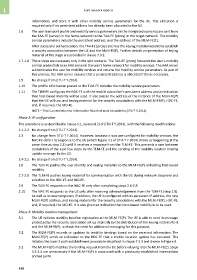Page 498 - 5G Basics - Core Network Aspects
P. 498
1 Core network aspects
information, and store it with other mobility service parameters for the UE. This allocation is
required only if no persistent address has already been allocated to the UE.
1.6 The user transport profile and mobility service parameters (in the integrated scenario) are sent from
the TAA-FE (server) in the home network to the TAA-FE (proxy) in the target network. The mobility
service parameters include the persistent address, and the address of the MLM-FE(C).
After successful authentication, the TAA-FE (proxy) also has the keying material needed to establish
a security association between the UE and the MLM-FE(P). Further details on generation of keying
material at this stage are provided in clause 7.3.2.
1.7-1.8 These steps are necessary only in the split scenario. The TAA-FE (proxy) forwards the user's mobility
service credentials to an AAA server in the user's home network for mobility services. The AAA server
authenticates the user for mobility services and returns the mobility service parameters. As part of
this process, the AAA server ensures that a persistent address is allocated if this is necessary.
1.9 No change from [ITU-T Y.2014].
1.10 The profile information passed to the TLM-FE includes the mobility service parameters.
1.11 The TLM-FE configures the NAC-FE with the mobile subscriber's persistent address and an indication
that host-based mobility will be used. It also passes the address of the instance of the MLM-FE(P)
that the UE will use, and keying material for the security associations with the MLM-FE(P), HDC-FE,
and, if required, the NID-FE.
NOTE – This is an entirely new information flow that must be added to [ITU-T Y.2014].
Phase 2: IP configuration
The procedure is as described in clause II.1, numeral 2) of [ITU-T Y.2014], with the following modifications:
2.1-2.2 No change from [ITU-T Y.2014].
2.3 No change from [ITU-T Y.2014]. However, because it was pre-configured for mobility services, the
NAC-FE defers its response to the UE (which Figure II.1 of [ITU-T Y.2014] shows as happening at the
same time as step 2.3) until it receives a response from the TLM-FE. This prevents a race between
completion of the next few steps by the TLM-FE and the sending of the mobility location binding
update message by the UE.
2.4-2.5 No change from [ITU-T Y.2014].
2.6 The TLM-FE pushes the user identity and keying materials to the MLM-FE(P), indicating host-based
mobility.
2.7-2.8 The TLM-FE pushes keying material for communication with the UE during network discovery and
selection to the HDC-FE and NID-FE.
2.9 The TLM-FE responds to the NAC-FE only after completing steps 2.6-2.8.
2.10 The NAC-FE responds to the UE only after receiving acknowledgement from the TLM-FE (step 2.9).
As well as its new temporary IP address, the UE is configured with its persistent IP address, the new
MLM-FE(P) address, and keying material for the security associations with the MLM-FE(P), HDC-FE,
and, if required, the NID-FE. It is also given an indication that host-based mobility is to be used.
Phase 3: Mobility location management
3.1 The UE initiates mobility location registration at the MLM-FE(P). The UE is able to send its message
protected by the security association set up implicitly by the distribution of the keying material to it
and the MLM-FE(P), without the need for additional messaging for this purpose,
3.2 The MLM-FE(P) records or updates its mobility bindings based on the received information. The
MLM-FE(P) sends an indication to the HDC-FE that a mobile location update has occurred. This
initiates the layer 3 path establishment procedure described in clause 7.3.3 and shown in Figure 9.
3.3 The MLM-FE(P) modifies the binding request from the UE before relaying it to the MLM-FE(C). Steps
3.3-3.4 are unnecessary if the MLM-FE(P) is associated with a previously-established intermediate
anchor point.
488

